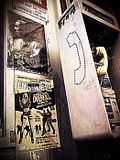Tuesday, April 24, 2012
Parallel Universes
The very personal world that we consider ourselves to be part of is entirely determined by self-definition. Many elements combine to make up our sense of self: past histories and experiences, the friends we choose to surround ourselves with, our mates, life partners and children, the jobs we do, the dwellings we occupy, the material objects we possess. These are just a few of the many components we use to construct our realities.
One of the key elements involved in our self defined realities is health, which can easily be taken for granted when things are going good. Once our physical well-being is delivered a serious blow, though, health suddenly leaps to the forefront, and if the diagnosis is serious enough, it can eclipse the total influence of all the other fundamentals combined. A chronic and debilitating illness can not only jump to the head of the line, but can bend, spindle, and mutilate many of the elements of a world that we had only recently felt so safely a part of.
At the moment of diagnosis, the newly ordained MS patient is blasted out of the reality they once knew and into a sort of parallel universe. None of the externals have yet likely changed much, but inside the patient a Big Bang has taken place, as former assumptions of self identity disintegrate, and new clusters of definition start forming through a haze of questions, shock, and confusion. Frustratingly, the outside world continues on as if nothing has happened, a perpetual motion machine that stops for the problems of no single person. As much as we may desire a timeout, just to catch our breath, none is granted. We must adjust to our new reality on the fly, which only adds to the sense of disorientation.
While we still exist in the world of the healthy, we are no longer truly a part of it, set adrift by the knowledge of a disease that lurks inside us, leaving us living in a world apart. Though a seismic shift has taken place, as long as the disease remains relatively mild the fissure is slight, the changes within at first recognizable only to the patient themselves. Our friends and family, when told of our predicament, offer heartfelt sympathy and measures of comfort, which of course are welcomed and much needed. What they can't offer, though, is a true understanding of the nature of the beast, as that damnable knowledge can only be fathomed by those who have been through the crucible of a body beset by disease .
Those of us unfortunate enough to quickly suffer the progressive disabilities for which MS has earned its cloak of dread soon see the chasm between our new reality and the one we used to occupy ever widen. While the members of the healthy population (sometimes called "Muggles" on some Internet MS sites) perform such amazing feats as effortlessly standing and walking, they cannot know the guttural anguish and inconceivable frustration involved in losing such abilities. Paralysis is one of the most feared conditions known to humanity. For good reason, most shy away from even the thought of it.
Those who love us, and in some cases take care of us, do their best to comprehend, and certainly suffer a brand of anguish and frustration all their own, but they are gratefully not of the world in which we now reside. Although they may empathize with us, only by living inside our skin could those who care ever truly know, and that is a fate I wouldn't wish on those I can't stand, never mind people I like and love.
Although we still occupy a place in their world, to the healthy our reality is an alien environment, beyond the grasp of those who are not residents. This can sometimes lead to seemingly callous remarks, or an apparent ham-fisted disregard to the sensitivities of the situation, but by and large I've found my dear Muggles do a remarkably good job of affectionately helping me navigate a world full of physical and emotional pitfalls that they themselves cannot see but with effort can get some sense of, like a blind person using a stick to navigate their way across Broadway. For this I consider myself lucky, as I know other patients have been left on their own by partners and loved ones who could not reconcile these new imperfect circumstances with their own versions of reality.
Strangers can be a different lot, as most are unfamiliar and uncomfortable with members of the world of the sick, who some may see as somehow diminished, and as reminders that their own complex reality is built on foundations of gossamer. Though most behave with a fair amount of grace, there are those who overcompensate to the alien in their midst, and say or do some incredibly stupid or insensitive things. I generally try to cut them some slack, as I when was in their shoes I was just as capable of committing similar stupidities.
Unlike the friend, lover, caregiver, or stranger who most likely has only ever lived in the land of the healthy, those of us with chronic illness have straddled two worlds. We the sick can remember a time when we were part of the healthy world, even if it now often seems like something of a place of wonder, and sometimes one of intense frustration. I can remember how wonderful it was to be free of disease, to be able to perform now impossible feats without even giving them so much as a fleeting thought. Although we may no longer be of that world, we still live in it, and within it we are constantly confronted with echoes of our own healthy past. I must admit to the occasional feeling of jealousy when watching a couple stroll hand-in-hand, or when my gaze sets upon somebody doing something as mundane as bending down to tie their shoe lace. How glorious to be unencumbered by a rebellious body, and what a rotten twist of fate to be saddled with disease. Still, though we might not be masters of our fate, we can and must be masters of our own reality.
Regardless of the world we live in, we owe it to ourselves to find contentment. Despite physical infirmity, our realities are still shaped by our thoughts, emotions, and perceptions, all of which can be harnessed, as they are a product of us, and not we of them. In each moment lies a kernel of good, and like a gold nugget it can sometimes be found resting right on the surface, but more often lies hidden under a pile of muck, requiring conscious effort be expended to discover it. By concentrating on what we have rather than what we've lost, on those who have shown us kindness rather than those who have been harsh, on this very moment rather than an irretrievable past or an unpredictable future, we can shape a reality that transcends the parallel universes of the healthy and the ill and find a place of self fulfilling satisfaction, where a diminished body needn't dictate a diminished existence.
Monday, April 16, 2012
Bits and Pieces: a Smorgasbord of MS Info
| A photograph of part of page 65, Woman's Home Companion, August, 1921, to get the 1921 Underwood logo (Photo credit: Wikipedia) |
(To those who receive these posts via e-mail, this post contains several videos, which can only be viewed on the Wheelchair Kamikaze website…)
Well, how often do you get to see the word smorgasbord in print these days? Seems when I was a kid, back in the 70s, you heard the word smorgasbord a lot more. But then again, maybe it was just my family, although I don't know why a working-class Jewish family in Queens would use the word smorgasbord all that much. So, I'll go back to my original premise and suppose that smorgasbord was used in everyday conversation more back in the decade of leisure suits and disco balls, neither of which are seen much these days, either.
Actually, there was a famous commercial back then for Underwood Deviled Ham that featured a child actor who looked like a living Cabbage Patch kid, Mason Reese (click here), saying that the stuff tasted like a "borgasmord", so that might explain my associating the 70s with smorgasbords. On a side note, I once saw a teenage Mason Reese in the Museum of Natural History, and thought he'd have made a better display than patron.
Anyway, for those unfamiliar with the word, a smorgasbord is nothing more than a buffet, Swedish style. I'm not a big fan of buffets, they seem somehow unsanitary and besides, I like being waited on. And now that I'm stuck in a wheelchair and have only one working arm and hand, doing the buffet thing would probably be all kinds of difficult, so I guess I no longer need to be concerned about buffets at all. See, every cloud has a silver lining.
Okay, enough mindless prattle, here's this month's buffet of MS and disability related info, so take what you will and try not to sneeze on the rest, as other people will be reading it after you.
♦ Starting out on the ever popular CCSVI front, several studies presented at this year's annual Society of Interventional Radiology (SIR) conference demonstrated that CCSVI treatment appears to positively benefit a cohort of MS patients (click here). Like almost all studies of this type conducted thus far, these studies were done retrospectively, using patient reported outcomes, which are generally regarded as less accurate than more strict scientific research methodology. In any event, the reports generally fall in line with previously reported data, finding that the symptoms most likely to be beneficially impacted were "quality-of-life issues" such as fatigue, cognitive function, and heat sensitivity. While these tidbits are encouraging, there are more rigorous treatment trials underway, so hopefully we'll have some robust data to chew on sooner rather than later.
On the negative side, a study on mice (click here) who had their jugular veins ligated (read "snipped") found that they did not develop any nervous system dysfunction as a result of the damage to their jugulars. As mice don't ever really develop MS (the most widely used mouse model of MS isn't MS at all, but rather is an allergic reaction induced by researchers), I'm not sure how much weight to put behind these findings. I believe similar research is being done on marmosets, which kind of sucks because marmosets are really cute, but the results of marmoset research would be much more convincing.
The lead singer of the Divinyls, Christina Amphlett, has MS, and recently had CCSVI treatment (click here for video). She says that the treatment definitely benefited her, and I'm sure all of you who enjoyed her signature tune "I Touch Myself" back in the 90s will join me in wishing her well. Now, stop that or you'll go blind…
♦ Turning now to the wide world of MS drugs, it seems that the new oral drug Gilenya has taken it on the chin lately. The drug is now under review in several countries because of safety issues (click here), after a number of deaths due to cardiovascular side effects were suspected. Additionally, a patient on the drug recently developed PML (click here), although that patient had previously been on Tysabri, which somewhat clouds the picture. Since Gilenya is the first oral MS drug, its release was generally greeted warmly in the MS community, but the mechanism of the drug would appear to be somewhat troublesome. Gilenya traps T cells within the lymphatic system, thereby keeping them from patrolling anywhere in the body, which one would assume might have negative repercussions on the body's ability to fight infections and other maladies. As usual, it's a complicated picture, as Gilenya may have neuroprotective properties (click here), and such properties have long been one of the holy grails of MS research. Neuroprotection good, patient deaths bad.
In other drug news, a recent study provides evidence that the CRAB drugs don't do anything to slow MS disease progression, even though they do reduce MS relapses and white matter lesions (click here). The study spanned 10 years and looked at 262 patients. Another study showed that cannaboids (the good stuff in marijuana) inhibited disease progression in mice (click here), but, as I stated earlier, the mouse model of MS is really pretty terrible. Still, the case for medical marijuana only seems to be getting stronger, so smoke 'em if you got 'em…
♦ The Multiple Sclerosis Association of America (MSAA) does some terrific work, and has programs designed to help MS patients in financial need acquire safety and mobility equipment at little or no charge (click here). They have a similar program involving the distribution of cooling equipment (click here), which can be a godsend during the hot summer months for those of us bedeviled by heat sensitivity. If you are a US citizen struggling financially during these tough economic times, please don't be shy about taking advantage of these truly wonderful programs.
♦ Movement on Wheels (click here) is a social networking site designed specifically for wheelchair users. The site is very new, and doesn't yet have many members, but I think the idea is a great one and I wish Movement on Wheels much success. If you are a wheelchair or scooter user, I'd encourage you to check out the site and help it become a thriving community.
♦ For those interested in learning about buying wheelchair accessible vans, this site has a lot of valuable information (click here). I'm not endorsing the company that runs the site, but they have put together an impressive website chock-full of really good info, and knowledge is power.
♦ A company in Italy, Genny Mobility (click here), is marketing a wheelchair made from converted Segways. The chairs are not yet available in the US, and the website is strictly an Italian, but check out the videos to see just how cool this little beast is. Looks like riding around in one would be a hell of a lot of fun, and I appreciate the con mucho gusto attitude that the inventor/marketer displays in the videos. Here's a video of the inventor riding around with his very adorable dog, and please forgive me for subjecting you to "Who Let the Dogs Out", a tune that the world could have very easily lived without:
♦ In my never-ending quest to shine a spotlight on assholes, here are a couple of pieces about jackasses ripping off the disabled. The first (click here) involves a chap in England who seems to specialize in robbing the vulnerable, and the second (click here) details the theft of computers from a Georgia office of the NMSS. To the miscreants involved in these incidents, I wish a pox on you and all your ancestors.
Just to make up for the "Who Let the Dogs Out" thing up above, I'll leave you with a much more pleasurable listening experience. Although I don't understand a word of French (okay, maybe I understand a few words) I listen to a lot of French music. I got started on Jacques Brel (a Belgian, actually) a few years ago, and since then a wide variety of chanteurs and chanteuses have been finding their way into my ear holes. Here's one of my more recent discoveries, Emily Loizeau. The song even has a bit of English in it, expressing a sentiment I think we can all identify with:
Related articles
- Gilenya in Ireland... or not? (willeke73.wordpress.com)
- Safety of MS pill Gilenya reviewed after deaths (cbc.ca)
- The medical politics blocking CCSVI trials (macleans.ca)
Saturday, April 7, 2012
Some New Photos, Some Shot with a New Toy
| The camera in the iPhone 4S (Photo credit: Wikipedia) |
It's been a while since I added new photos to the gallery (featured in the sidebar on the left), so here's another batch. The first seven were shot with my usual wheelchair mounted camera rig (click here for info). I recently upgraded my camera to a Panasonic Lumix GH2 (click here), for which I am quickly developing an affection, but that's not the new toy I'm talking about in the title of this post…
My newest gadget is (drumroll please)… an iPhone! The remaining 11 photos posted down below were all taken with my new iPhone 4S, a device I resisted buying for several years because I just didn't want to join the cult of Apple. I know, I know, people love Apple gizmos and will line up for days to get the latest and greatest (I have an Apple Store on the corner of my block), but I've always found the whole Apple thing to be more than a little annoying. Maybe it's just the contrarian in me, but I generally don't like "smug", and Apple as a social phenomenon is nothing if not smug. Yes, their design studios turn out physically beautiful products, and they did reinvent the way we interact with our computers (remember the days of Microsoft DOS, blech), revolutionize the way we purchase and listen to music (and in the process destroy the monolithic music industry, which, even though it employed me, might not be a bad thing) and even change the whole concept of what a phone should be, but I always resisted the Apple siren song because of the smugfest that enveloped it.
What finally won me over was the inclusion of a relatively high-quality eight megapixel camera in the newest iPhone, and all the fun photography apps designed for it that I kept reading about on the various photo websites I like to poke around in. The Siri feature, which lets you talk to the phone and access many of its functions by voice command was also a selling point, as it’s a very disability friendly option, but the big draw for me was the photo potential.
Despite my initial reticence, I have to admit that the iPhone is a pretty neat device. I have gone a little nuts with the photo apps, but hey, at the cost of one or two bucks each I can afford to splurge, and many of them do some impressive tricks. Though I've always used Photoshop to process my photos, I generally try not to tinker with them too much, preferring to stick with traditional in camera photography and the digital version of old-school darkroom techniques. With the iPhone and all of its many photo apps, though, I just can't help myself but mess around with the photos in a zillion different ways, as you can probably see from the examples below. It's easy to overdo it with some of the effects because the apps make it so terribly easy and some self-control is definitely required, but there's something about making pictures with the iPhone that is tremendously addictive. The quality of the photos it produces is nowhere near that of a dedicated high-end interchangeable lens digital camera, but for a phone - zowie!
An unexpected benefit that I really didn't anticipate before getting the iPhone is that it allows me to handhold the camera, which is very liberating after years of taking photos with a camera firmly mounted to the arm of my wheelchair. The iPhone camera can be operated with one hand (which is a good thing for someone who only has one gimpy but for the time being still working hand), and the photos I take with it are much more like my photos of old, prior to MS (or whatever the hell I have) forcing a very disciplined style of shooting on me. Before MS stole the use of my right arm, I used lots of toy and/or antique cameras, because I loved the dreamy, seemingly haphazard, and often surreal images they captured. Well, the combination of the small footprint of the iPhone and its many available photo apps has allowed me to digitally re-create what I used to do organically. Naturally, I'd give my right arm (snicker) to be able to go back to doing things as I did in my healthy days, but, as they say, any port in a storm…
Okay, enough with my endless blatherings. Presented for your perusal are the following 18 photos (click thumbnail for larger image), on which I'd love to get your feedback. Feel free to critique at will, as I'd like to know which ones you hate as well as which you like, so please don't be shy about leaving your impressions in the comments section at the bottom of the post.
Oh, I almost forgot, since a bunch of readers have inquired if and where they might buy some of my photos, I'm looking into setting up a website that would allow folks to do so. I don't want to generate any income from selling them, but I would like to further MS research, so any profits realized would be donated to various MS charities. More details to follow, as they become available…
 |  |  |  |
 |  |  |  |
 |  |  |  |
 |  |  |  |
 |  |
Related articles
- New patent sheds light on Apple's camera tech (images) (news.cnet.com)
- Steve Jobs wanted to reinvent iPhone photography, says book (news.cnet.com)
- Should I break up with my iPhone for Nokia's Lumia 900? (news.cnet.com)

Subscribe to:
Comments (Atom)




